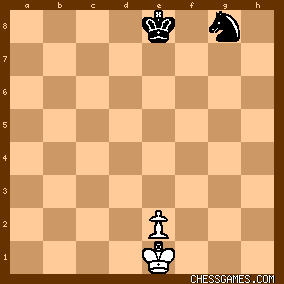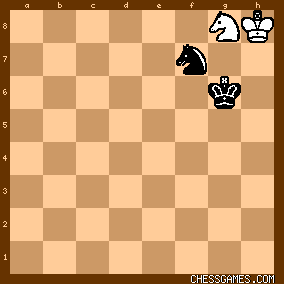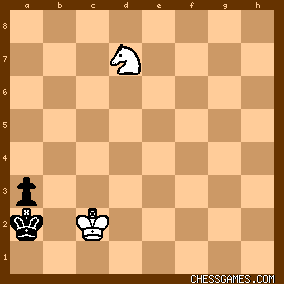|
< Earlier Kibitzing · PAGE 5 OF 5 ·
Later Kibitzing> |
| Apr-22-11 | | parmetd: what time does the playoff start for Shankland/Onischuk? |
|
Apr-22-11
 | | gmhammer: 3 pm Eastern |
|
| Apr-22-11 | | wordfunph: <parmetd>
To follow the tiebreaks on Friday, log on to www.uschesschamps.com at 2 p.m. local, 3 p.m. Eastern. http://www.chess.co.uk/twic/chessne... |
|
Apr-22-11
 | | Peligroso Patzer: <parmetd: what time does the playoff start for Shankland/Onischuk?> It starts today at <2:00 p.m. local time (Central Daylight)>. That is 3:00 EDT in the U. S. There is a schedule for the Championships (April 14-28) at the bottom of this page: http://saintlouischessclub.org/2011.... |
|
| Apr-22-11 | | SuperPatzer77: <FSR> and <Peligroso Patzer> Is the official score of the Finegold-Shabalov game 0-1? The original score of this game was 1-0 but it has been corrected to 0-1, right? I'm a bit confused about the result.
SuperPatzer77 |
|
| Apr-22-11 | | boz: If you look at the final position you'll see that Black has bishop, knight and king while White has nothing but a king. |
|
Apr-22-11
 | | Peligroso Patzer: <MaxxLange: <FSR> you have to have theoretical mating material on the board to win by the opponent's flag falling.> The initial confusion over the result in yesterday's game, Finegold vs. Shabalov, has raised some interesting rule interpretation possibilities. With regard to <MaxxLange>'s comment, I believe <FSR> was addressing the possibility of forfeit due to a <cell phone> ringing. The result in that scenario would seem to depend on the regulations for the particular event, and possibly on TD discretion and judgment. In any event governed by the FIDE Laws of Chess (as is the U.S. Championship), Rule 13.4 grants the arbiter large discretion to impose a wide range of sanctions for almost any rules violation. Also, the rule on wins with very reduced material due to the opponent's <time forfeiture> is usually stated as you posted (viz, in terms of "mating material"), but it is actually somewhat more complicated. For example, in this position: 
click for larger view... if White's flag falls it would be a draw under USCF Rule 14E2, but as I interpret FIDE Rule 6.10, Black would get a win with just King and Knight on the board. The relevant part of that rule (which addresses losses by time forfeiture) reads, "... [h]owever, the game is drawn if the position is such that the opponent cannot checkmate the player's king by any possible series of legal moves, even with the most unskilled counterplay." The point is that the stated condition to make the result a draw is not met in this example because it is legally possible for play from the position in the diagram above to result in this position: 
click for larger view |
|
| Apr-22-11 | | drnooo: Perhaps it's just I, but this format seems a fine one for a world championship match: the best fourteen in the world getting together just as with this: it gives enough leeway for any up and comers to rise, plenty of games to sort out the winners and losers. Not sure how the official thing is set up, but I probably like this one better. |
|
| Apr-22-11 | | Marmot PFL: It looks like Skankland has eliminated Onishuk, winning a long game with several passed pawns against a knight. |
|
| Apr-22-11 | | waustad: It is great to see Hess and Shankland doing so well. We haven't seen this kind of new blood, along with Robson in some years. Like Reshevsky years ago, maybe the post USSR diaspora will spread very high quality chess throughout North America as well as the rest of the world. I'm sad that Caruana chose Italy, but maybe US teams will soon be able to have more home grown members. |
|
| Apr-22-11 | | hellopolgar: Shankland's twitter btw
http://twitter.com/#!/GMShanky |
|
Apr-23-11
 | | Peligroso Patzer: Game scores from yesterday's playoff are not yet in the database. Here are the moves: <2011 US Chess Championships Playoffs (preliminary stage),
St. Louis, MO, USA, 22 April 2011>
<Game #1
White: Onischuk, Alexander
Black: Shankland, Samuel>
1.c4 c6 2.e4 d5 3.exd5 cxd5 4.d4 Nf6 5.Nc3 Nc6 6.Bg5 dxc4 7.d5 Ne5 8.Nf3 Bg4 9.Be2 Bxf3 10.gxf3 g6 11.Qd4 Nd3+ 12.Bxd3 cxd3 13.d6 Bg7 14.Qa4+ Qd7 15.Qxd7+ Kxd7 16.dxe7 h6 17.Be3 Kxe7 18.O-O-O Rhd8 19.Rd2 Rac8 20.Re1 Kf8 21.Red1 a6 22.Rxd3 Rxd3 23.Rxd3 Ke7 24.Bd4 Nh5 25.Kd2 Bxd4 26.Rxd4 Nf6 27.Ke3 Rc5 28.Rh4 Re5+ 29.Kd4 Rf5 30.Ke3 Re5+ 31.Kd4 Rf5 32.Ke3 Re5+ 1/2-1/2 <Game #2
White: Shankland, Samuel
Black: Onischuk, Alexander>
1.d4 Nf6 2.c4 e6 3.Nc3 Bb4 4.f3 d5 5.a3 Bxc3+ 6.bxc3 c5 7.cxd5 Nxd5 8.dxc5 Qa5 9.e4 Nf6 10.Be3 O-O 11.Qb3 Nfd7 12.a4 Qc7 13.Qa3 b6 14.a5 Bb7 15.Ne2 Nxc5 16.Nd4 Nbd7 17.Be2 Ba6 18.Bxa6 Nxa6 19.O-O Qc8 20.Nb5 Nac5 21.Qb4 Nd3 22.Qd4 N7c5 23.Rfb1 Rd8 24.Qc4 a6 25.axb6 axb5 26.Qxb5 Rxa1 27.Rxa1 Nb7 28.Bd4 e5 29.Qxd3 exd4 30.cxd4 Rd6 31.Rb1 Rc6 32.Qe3 Rc3 33.Qf4 h6 34.h4 Rc2 35.d5 Qc5+ 36.Kh2 Qf2 37.Qb8+ Kh7 38.Qg3 Qd4 39.Qf4 Kg8 40.Qb8+ Kh7 41.Qf4 f6 42.h5 Qe5 43.Qxe5 fxe5 44.Kh3 g6 45.Ra1 Rb2 46.Rc1 Rxb6 47.Rc7+ Kg8 48.hxg6 Na5 49.Rc5 Nb3 50.Rc6 Rb7 51 Re6 Nd4 52.Rxe5 Kg7 53.Re8 Kxg6 54.f4 Rb3+ 55.Kh4 Rd3 56.d6 Ne2 57.f5+ Kf7 58.Re7+ Kf6 59.Re6+ Kf7 60.Rxh6 Rd4 61.Re6 Nf4 62.Re7+ Kf8 63.Kg5 Nd3 64.e5 Nf4 65.g4 Nd5 66.Ra7 Ne3 67.Kf6 Nxg4+ 68.Ke6 Re4 69.d7 Rxe5+ 70.Kd6 1-0 source: http://main.uschess.org/content/vie... |
|
Apr-23-11
 | | FSR: <Peligroso Patzer ... if White's flag falls it would be a draw under USCF Rule 14E2 ...> Not so. In the position you are referring to, White has a pawn and Black a knight. White could promote the pawn to a rook, knight, or bishop, in which case it would be possible (assuming that the players essentially cooperate on a "helpmate" problem) for Black to checkmate White. Since is theoretically possible for Black to give checkmate, the game would be declared a win for Black. |
|
Apr-23-11
 | | HeMateMe: any results yet? |
|
| Apr-23-11 | | dangerhump: both semifinal games drawn...Shankland - Kamsky was interesting for a bit after Kamsky sacrificed his Bishop for the h3 pawn...but he missed the eventual Qf4-h2 manuever that completely defended and eventually gave white advantage...Kamsky had to fight for a draw at that point |
|
| Apr-23-11 | | dangerhump: I guess it would be more accurate to say he sacrificed bishop for two pawns |
|
| Apr-23-11 | | NMWillStewart: I covered A LOT of these games, much of this coverage has been shown for WGM Pogonina's site, on Susan Polgar's blog and tommorow it will be up on Chessdom. Check it out here: http://www.onlinechesslessons.net/2... |
|
| Apr-24-11 | | hedgeh0g: http://chessbase.com/newsdetail.asp...
Nice US Championship video with GM Hammer. Hammer reveals he's assisting Shankland, but appears reluctant to call himself a "second". My guess is it's due to his higher rating. |
|
Apr-24-11
 | | Peligroso Patzer: <FSR: <Peligroso Patzer ... if White's flag falls it would be a draw under USCF Rule 14E2 ...>
Not so. In the position you are referring to, White has a pawn and Black a knight. White could promote the pawn to a rook, knight, or bishop, in which case it would be possible (assuming that the players essentially cooperate on a "helpmate" problem) for Black to checkmate White. Since is <theoretically possible> for Black to give checkmate, the game would be declared a win for Black.> No, my original assertion (that K + P [with time expired] vs. K + N is generally a <draw> under USCF rules) was correct. Under that rule, what is "theoretically possible" is not determinative. The relevant part of <USCF Rule 14E2> reads as follows: “14E. Insufficient material to win on time. The game is drawn even when a player exceeds the time limit if one of the following conditions exists ***: “*** 14E2. King and bishop or king and knight. Opponent has only king and bishop or king and knight, and does not have a <forced win>.” [Emphasis added.] Thus, under the USCF rule (in distinction to the FIDE rule), what matters is whether the win can be FORCED, so <the result under USCF rules would be a DRAW>. As quoted above in my earlier post, the FIDE rule refers to “any possible series of legal moves”, so <FSR>'s analysis would be valid in that context (i.e., where the FIDE Laws of Chess govern), as also noted in my earlier post from Apr-22-11. <FSR> may have been thinking of USCF Rule 14D (Insufficient material to continue), which provides for a draw to be declared <at any point during a game> (regardless of how much time there is on either player’s clock) in several specified cases and generally, in subsection 14D4, when “[t]here are no legal moves that could lead to the player being checkmated by the opponent”. |
|
Apr-24-11
 | | FSR: <Peligroso Patzer> I'm sorry, I read your earlier post too quickly, and as a result misunderstood you. Never mind. |
|
Apr-24-11
 | | Peligroso Patzer: BTW, for an instance of a position where even under USCF rules (not actually applicable, since the game was played in the 2001 Cuban Championship) a player could win with just his king and a knight on the board upon his opponent's time running out, the position <after 81. Kc2>
in
J Nogueiras vs M Gongora, 2001: 
click for larger view ... is a forced mate by White thanks to the Black king's being trapped in front of its own a-pawn on the 6th rank. (In the actual game, Black apparently resigned after the further <81. ... Ka1 82. Nc5 Ka2 (if 82. ... a2 then 83. Nb3#) 83. Nd3 Ka1 84. Nc1> 1-0, in the face of <84. ... a2 85. Nb3#>.) |
|
| Apr-24-11 | | haydn20: <Peligroso> thx for your post. I ran the first 23 moves of game 2 thru Fritz, where it evaluates to 0.00. I played thru the rest "by hand" and somewhere after 41...f6 White got a better game. Beats me. I hope someone has some analysis of this game. |
|
Apr-24-11
 | | Peligroso Patzer: <haydn20: <Peligroso> thx for your post. ***> You're welcome. (I assume you are referring to the post with the two game scores from the Shankland - Onischuk playoff on Friday.) Hopefully those games will soon be included in the CG.com database. |
|
Apr-27-11
 | | Peligroso Patzer: I just got on-line a short while ago, and it appears that the tie-break for 3rd place between Shankland and Hess consisted of a single Armageddon game. The regulations I found on-line (as posted on page 3 of this thread) provided for a tie-break to consist initially of "a two-game rapid match (G/25+5 second increment)", and only if that was indecisive, then to resort to Armageddon. By its terms, this procedure applied to semifinals and finals tie-breaks, so maybe it was decided it did not apply to a tie-break for third, but this would seem rather strange. Does anyone have a definitive explanation why there was no 2-game rapid match? |
|
Apr-28-11
 | | Peligroso Patzer: Here is a link to a page for the two-game playoff between Shankland and Onischuk: US Championship (Group B Playoff) (2011) ... and to the page for the semifinals and finals:
US Championship (Knock-Out) (2011) |
|
 |
 |
|
< Earlier Kibitzing · PAGE 5 OF 5 ·
Later Kibitzing> |





